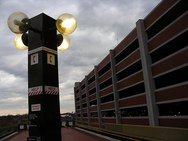Metro parking prices should reflect crowding
Metro garages and lots charge a flat fee for all-day parking on normal work days. Local governments can also add surcharges to pay for improvements like new garages. But it doesn’t account for demand.
WMATA should change this policy. Instead, they should increase the price at the fullest lots, and consider reducing prices at lots that never fill up.
They provided us with recent parking occupancy data. Here are the lots that are the fullest and least full:
| Fullest parking | Least full parking | ||||||||||||||||||||||||||||||||||||||||||||||||||||||||||
|---|---|---|---|---|---|---|---|---|---|---|---|---|---|---|---|---|---|---|---|---|---|---|---|---|---|---|---|---|---|---|---|---|---|---|---|---|---|---|---|---|---|---|---|---|---|---|---|---|---|---|---|---|---|---|---|---|---|---|---|
|
|
The WMATA Board could establish a set of guidelines for changing parking pricing. Those guidelines could ask instruct staff to review the prices quarterly, consider increasing the prices where the average weekday occupancy is over 90%, and to change the daily rate no more than fifty cents at a time.
The staff should be required to produce regular public reports to riders and the Board, but have the freedom to make adjustments in line with the policy on their own. The Board could set a maximum price for parking, somewhere between $1-2 more than the current price.
Additionally, in an effort to spur ridership, Metro should consider dropping the price at lots where the spaces are no more than 70% full on the average weekday.
Based on that, the lots and garages listed in the left-hand table above should see parking rate increases, while prices should decrease in the lots and garages on the right side.
To confirm this data, Metro could send station managers, line supervisors or other personnel to these stations and verify when the parking lots fill up. If they fill up before 8:30 am, well before the morning rush is over, then potential customers are being turned away. We want everyone who comes before the end of rush hour to be able to find a space, because they’re taking traffic off the roads when they’re more likely to be congested, and because they’re willing to pay full fare.
An interesting side-effect of this policy might be reducing the need for Metro’s reserved spaces, where Metro charges a monthly fee to hold a space open for you until 9:30 am. With higher parking lot prices, spaces will stay open automatically, and fewer people will need to get a reserved parking pass. Overall, this will likely increase Metro’s revenues as prices on regular spaces, which outnumber the reserved spaces, increase as the number of reserved spaces decrease. Eventually, there will not be a need to administer a reserved parking program.
Besides using some of the revenue to close its ever-present budget gaps, WMATA could devote a portion of the increase to improving local pedestrian and biking conditions at stations with price increases. Another thing that would help out both Metro and its customers would be to install entry sensors at each of the station parking lots. Other cities like Santa Barbara have used these to better understand usage patterns for their downtown parking garages. They’ve also put the real-time data online so that potential customers can check to see how full the garages are before they travel.
Metro’s current parking prices are not based on anything other than a general sense of fairness for drivers, and a comparison of what local garages are charging, as well as any surcharges the local governments have put on the lots to pay for improvements. But parking at a Metro station is a different product than local lots, and this pricing scheme has resulted in large disparities in lot usage. WMATA should use the already existing parking lot occupancy data to reduce these disparities, while devoting a part of the revenue to improving local conditions and installing equipment to improve the data they collect and provide to customers.

